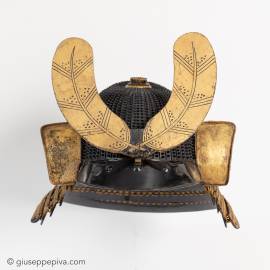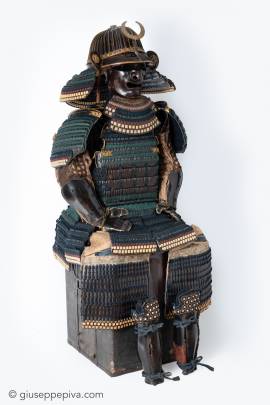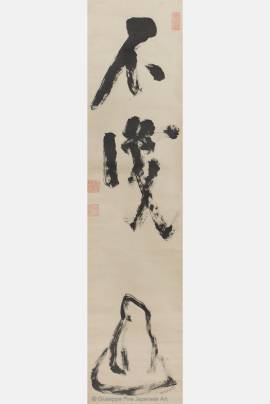Samurai helmet with standing rivetsHaruta SchoolMomoyama to early Edo Period, 17th Century A 62-plate koboshi-bachi [helmet bowl with small standing rivets] with 31 pointed rivets on each plate decreasing in size towards the top, with the exception of the larger front plate, with three lines of rivets and the small one on the back which is left blank, for a total of 1,953 rivets.The kabuto is fitted with a gold-lacquered five-plates neck protection (shikoro) of hineno style, typical of the period.The tsunomoto riveted on the visor holds a wooden front decoration (maedate)...
WORKS FOR SALE
Complete samurai armorEarly Edo Period, 17th century Kabuto [helmet]: 32-plate so-fukurin kabuto. The shikoro (neck guard) is all in hon-kozane (true scale), divided in three sections.Menpō [mask]: A rare lacquered iron ressei-men (mask with fierce expression) with a large nose and no mustache.Dō [cuirass]: Maru-dō (made in a single piece) with hon-kozane (true scale) construction. The lacing is in two different style, with a difference in the central part (munakoshitori); gilt-brass rims and fine pierced kanamono (application).Sode [shoulder guards]: Mid-size type (chu-sode), with a cut...
Jiun Onko (1718 - 1804)Daruma: “I do not know”Ink on paper, 25 x 104.5 cmWith the artist’s sealsProvenance:Tohara Ideo collection, OsakaExhibitions:“Schrift und Bild”, Stedelijk Museum Amsterdam and Staatliche Kunsthalle Baden-Baden, 1963This painting represents the first Zen patriarch, often referred to as Daruma in Japanese, but more properly called by his Sanskrit name Bodhidharma. He is believed to have been moved from India to China in the fifth and sixth century and there, through meditation, finally came to understand the Buddhist law (dharma). This is why...
Copyright © 2016 - giuseppe piva - VAT: 05104180962










